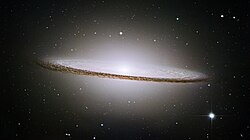Hubble Heritage Project
The Hubble Heritage Project was founded in 1998 by a team of astronomers. The aim was to use the raw images of the Hubble space telescope to create images of high scientific and artistic value.
The project publishes images of planets, stars, individual galaxies and groups of galaxies at monthly intervals. The success of the project is mainly due to the collaboration of experts from various scientific disciplines such as astronomy, computer and image processing.
Goals and approach
The astronomers and image processing specialists select the basis for their images from the public data archive of the Hubble Space Telescope . Since the raw images were usually taken for scientific purposes, they are often too underexposed for publication. The team then tries to create a high-quality image from the various archive recordings. The image of the Sombrero Galaxy , for example, was put together from six individual images .
The Hubble Heritage Project was also given a certain amount of observation time for the Hubble Space Telescope in case recordings need to be supplemented.
The project has received multiple awards for creating excellent astronomical images. The Astronomical Society of the Pacific awarded the project the Klumpke-Roberts Prize in 2003 for outstanding contributions to the general understanding and recognition of astronomy .
Some images from the project are featured on American and British postage stamps.
Web links
- Homepage of the project
- Organizations and strategies in astronomy , by André Heck (as Google Book)
